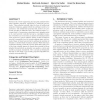81 search results - page 16 / 17 » On the (Im)possibility of Obfuscating Programs |
DRM
2005
Springer
14 years 4 months ago
2005
Springer
Advances in reverse engineering and program analyses have made software extremely vulnerable to malicious host attacks. These attacks typically take the form of intellectual prope...
NSPW
2003
ACM
14 years 4 months ago
2003
ACM
The ability to analyze and modify binaries is often very useful from a security viewpoint. Security operations one would like to perform on binaries include the ability to extract...
HPCA
2008
IEEE
14 years 11 months ago
2008
IEEE
As multicore systems become the dominant mainstream computing technology, one of the most difficult challenges the industry faces is the software. Applications with large amounts ...
ISCA
2010
IEEE
14 years 3 months ago
2010
IEEE
Phase change memory (PCM) is an emerging memory technology for future computing systems. Compared to other non-volatile memory alternatives, PCM is more matured to production, and...
CCS
2007
ACM
14 years 2 months ago
2007
ACM
Remotely-launched software exploits are a common way for attackers to intrude into vulnerable computer systems. As detection techniques improve, remote exploitation techniques are...

